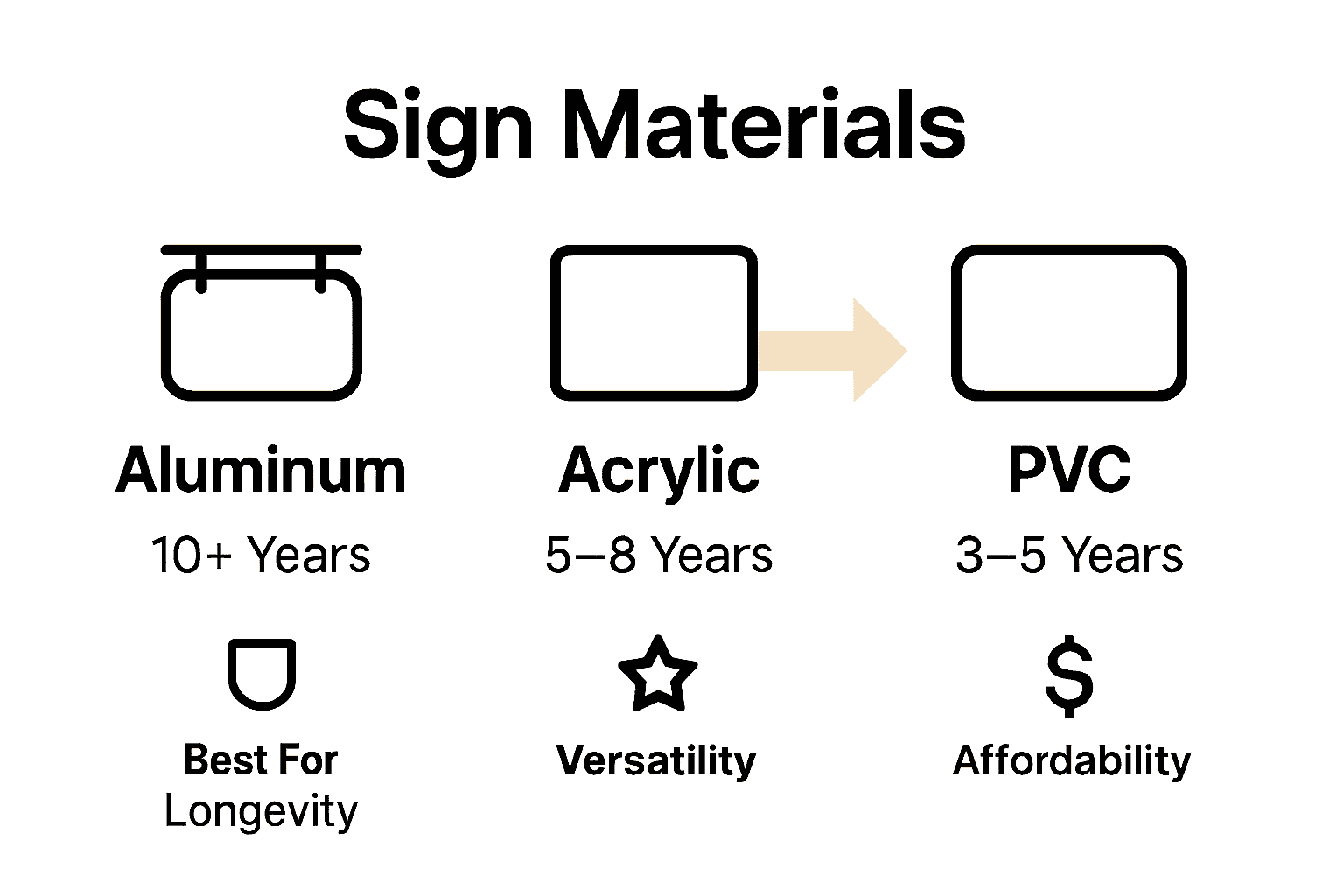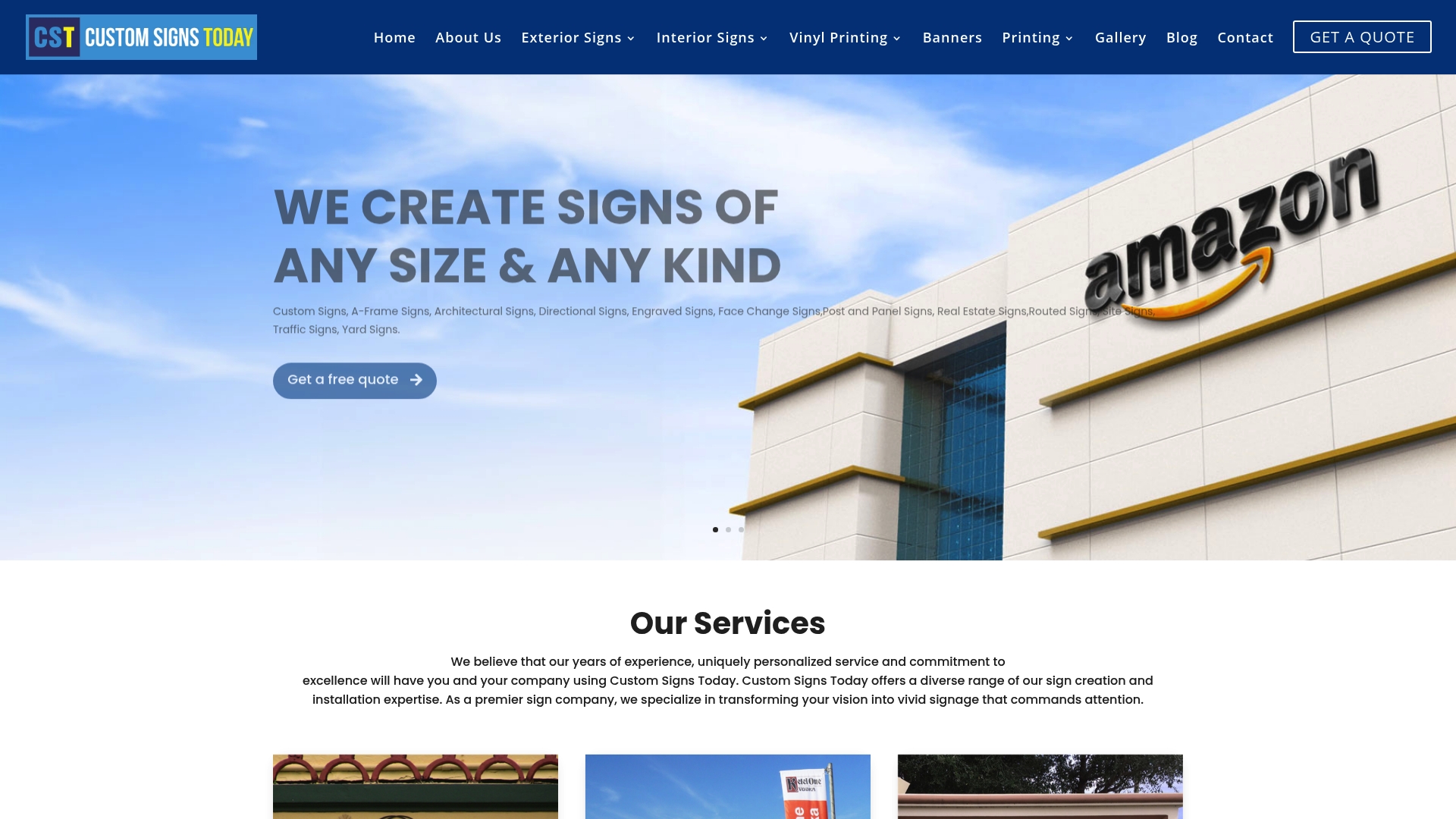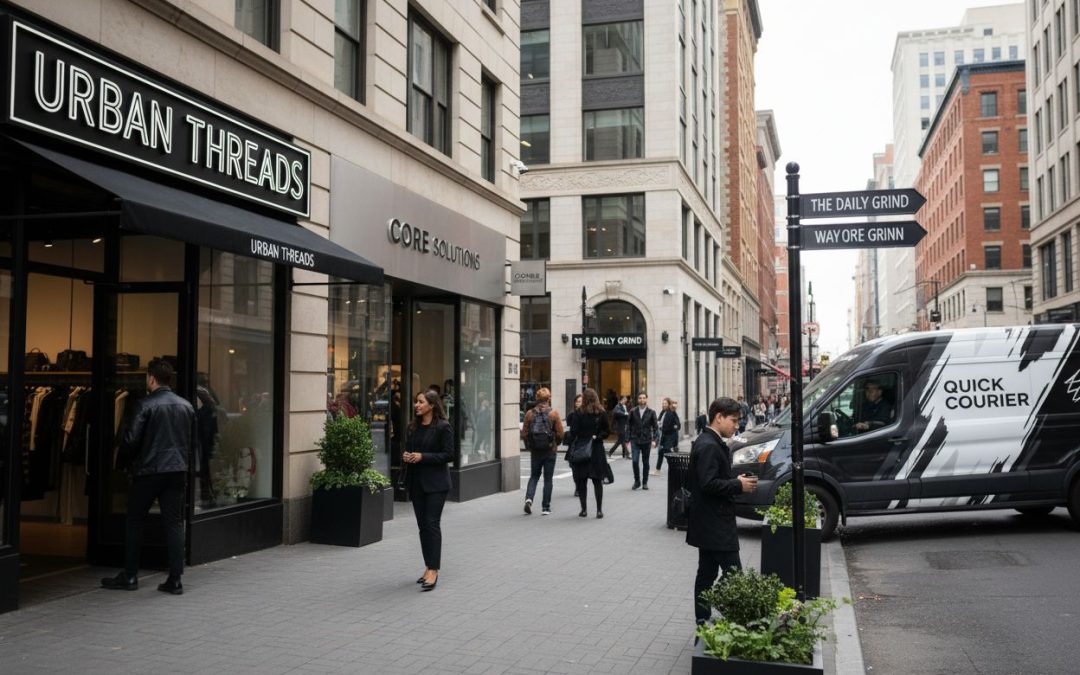Did you know that over 75 percent of customers say outdoor signs are their first impression of a business? The right signage can draw in new clients, provide key information, and make your brand memorable from the street. Whether you run a bustling retail store or a small café, choosing the right outdoor sign can shape how people think about your business and help you stand out from the crowd.
Key Takeaways
| Point | Details |
|---|---|
| Importance of Outdoor Signs | Outdoor signs are crucial for attracting customers, providing guidance, and building brand recognition, functioning as silent ambassadors for businesses. |
| Variety of Sign Types | Different types of outdoor signage, like monument signs and vehicle wraps, offer unique advantages and should align with specific marketing objectives. |
| Material Impact on Durability | The choice of materials affects sign longevity and performance, necessitating careful selection based on environmental conditions and usage context. |
| Regulatory Compliance | Understanding local regulations and permit requirements is essential to avoid fines and ensure that signage is legally compliant and effectively installed. |
Table of Contents
- What Are Outdoor Signs And Their Purpose
- Major Types Of Outdoor Signage Solutions
- Materials And Durability Factors Explained
- Design, Visibility, And Branding Essentials
- Legal, Zoning, And Installation Requirements
- Costs, Maintenance, And Common Mistakes
What Are Outdoor Signs and Their Purpose
Outdoor signs are visual communication tools designed to capture attention, convey information, and help businesses communicate with potential customers from a distance. Business signage serves multiple strategic purposes beyond simple decoration – these are powerful marketing assets that work 24/7 to attract attention, provide guidance, and build brand recognition.
At their core, outdoor signs function through several critical business objectives:
- Attracting potential customers by creating visual interest
- Providing directional information for navigation and wayfinding
- Establishing brand identity through consistent visual messaging
- Communicating essential business details like operating hours, contact information, and current promotions
The most effective outdoor signs blend strategic design with clear messaging. Learn more about custom exterior sign design to understand how professional signage can transform your business’s visual communication. Whether you’re a small local shop or a large commercial enterprise, outdoor signs act as silent ambassadors representing your brand’s personality and professionalism. They create first impressions, guide customers, and communicate your business’s core message without saying a word.
From storefront displays to roadside banners, outdoor signs come in numerous formats tailored to specific business needs. Each sign type carries unique advantages – monument signs offer permanent branding, vehicle wraps provide mobile advertising, and temporary event signs create immediate visual impact. The right outdoor signage strategy can significantly enhance your business’s visibility and customer engagement.
Major Types of Outdoor Signage Solutions
Outdoor signage encompasses a diverse range of visual communication tools designed to meet specific business needs. Each sign type offers unique advantages for attracting attention, conveying information, and enhancing brand visibility. Understanding these variations helps businesses select the most effective solution for their specific marketing and communication objectives.
The primary categories of outdoor signage include:
Here’s a comparison of major outdoor signage types and their advantages:
| Sign Type | Key Advantage | Typical Use Case |
|---|---|---|
| Monument Sign | Permanent branding | Business entrances |
| Channel Letter Sign | Night visibility | Storefronts, retail |
| Storefront Sign | High visibility | Shops, restaurants |
| Vehicle Wrap | Mobile advertising | Service vehicles, deliveries |
| Wayfinding Sign | Customer guidance | Office parks, campuses |
| Temporary Event Sign | Quick impact | Promotions, special events |
- Monument Signs: Permanent ground-level markers providing professional branding
- Channel Letter Signs: Three-dimensional illuminated lettering for storefronts
- Storefront Signs: Large-format displays showcasing business name and core offerings
- Vehicle Wraps: Mobile advertising platforms transforming vehicles into moving billboards
- Wayfinding Signs: Directional markers guiding customers through complex spaces
- Temporary Event Signs: Flexible banners and displays for short-term promotions
Explore our comprehensive guide to custom sign solutions to discover how different sign types can elevate your business’s visual communication strategy. The effectiveness of outdoor signage depends not just on the type of sign, but on strategic design, placement, and alignment with your brand’s visual identity. Businesses must consider factors like visibility, durability, local regulations, and target audience when selecting their ideal signage solution.
Beyond traditional static signs, modern outdoor signage technologies now include digital displays, interactive screens, and dynamic content management systems.
These advanced solutions offer real-time updates, enhanced engagement, and the ability to quickly adapt marketing messages. Whether you’re a retail store, restaurant, corporate office, or event organizer, choosing the right outdoor signage can dramatically improve your brand’s visibility and customer interaction.
Materials and Durability Factors Explained
Outdoor sign durability is a critical consideration for businesses investing in visual communication tools. The materials used in sign construction directly impact longevity, performance, and overall cost-effectiveness. Understanding the strengths and limitations of different materials helps businesses make informed decisions that balance aesthetic appeal with practical functionality.
Key materials used in outdoor signage include:
- Aluminum: Lightweight, corrosion-resistant, ideal for long-term outdoor installations
- Acrylic: Transparent, weather-resistant, perfect for illuminated signs
- PVC: Cost-effective, lightweight, suitable for temporary signage
- Stainless Steel: Extremely durable, professional appearance, high-end aesthetic
- Vinyl: Flexible material for wraps and temporary graphics
- Polycarbonate: Impact-resistant, ideal for high-traffic areas
Learn more about professional sign material selection to understand how material choices impact your signage performance. Durability isn’t just about withstanding weather conditions – it’s about maintaining visual quality, color integrity, and structural integrity over time. Businesses must consider factors like UV resistance, temperature fluctuations, humidity, and potential physical impacts when selecting sign materials.

Environmental conditions play a significant role in material selection. Signs in coastal areas require different material considerations compared to those in desert or mountain regions. High-quality signs incorporate protective coatings, specialized printing techniques, and engineering that anticipates potential stress factors. By investing in professionally crafted signs with appropriate material selection, businesses can ensure their visual communication remains sharp, professional, and effective for years.

Design, Visibility, and Branding Essentials
Outdoor sign design represents a critical intersection of visual communication, marketing strategy, and brand storytelling. Effective signage goes far beyond mere information display – it communicates a business’s personality, professionalism, and core brand message within seconds of viewer engagement. The visual elements, color schemes, typography, and overall composition work together to create an immediate and lasting impression.
Key design principles for impactful outdoor signage include:
- Color Psychology: Strategic color selection that evokes specific emotional responses
- Typography Clarity: Legible fonts that remain readable from multiple distances
- Visual Hierarchy: Organizing information to guide viewer attention
- Brand Consistency: Aligning sign design with overall brand visual identity
- Contrast and Readability: Ensuring maximum visibility in different lighting conditions
- Negative Space: Utilizing white space to enhance message comprehension
Explore expert branding strategies in our comprehensive blog to understand how visual design translates into powerful marketing communication. Visibility isn’t just about size – it’s about creating a visual experience that captures attention, communicates value, and creates an emotional connection with potential customers. Professional sign designers understand how to balance aesthetic appeal with functional communication, ensuring that every visual element serves a strategic purpose.
Successful outdoor signage acts as a silent ambassador for your brand, communicating professionalism and credibility before a single word is read. By investing in thoughtful design that considers viewing angles, environmental context, and target audience preferences, businesses can transform simple signs into powerful marketing tools that attract, engage, and convert potential customers.
Legal, Zoning, and Installation Requirements
Sign regulations represent a complex landscape of legal considerations that businesses must carefully navigate when planning outdoor signage. Local municipalities, county governments, and specific zoning districts maintain detailed ordinances governing sign placement, dimensions, illumination, and overall visual impact. Understanding these regulations is crucial to avoid potential fines, forced removals, or costly redesigns that can disrupt business operations.
Key legal and zoning considerations include:
- Size Restrictions: Specific dimensional limitations for different sign types
- Placement Guidelines: Required setbacks from property lines and public spaces
- Height Limitations: Maximum vertical dimensions for ground and mounted signs
- Illumination Regulations: Rules about lighting intensity and hours of operation
- Historic District Constraints: Special requirements for areas with preservation status
- Permit Application Processes: Documentation and approval procedures
Check our detailed guide on navigating local sign ordinances to understand the intricate legal landscape surrounding outdoor signage. Professional sign installation requires more than just aesthetic considerations – it demands comprehensive understanding of local building codes, structural requirements, and safety standards. Businesses must work with experienced sign professionals who can interpret complex regulatory environments and ensure full compliance.
Successful sign installation involves a multi-step process that goes beyond simple mounting. Structural assessments, electrical considerations, wind load calculations, and potential environmental impact all play critical roles in creating a legally compliant and safely installed outdoor sign. By investing time in understanding these requirements and partnering with knowledgeable professionals, businesses can develop signage solutions that are not just visually compelling, but also fully aligned with local regulatory standards.
Costs, Maintenance, and Common Mistakes
Outdoor signage investment represents a strategic business decision that extends far beyond initial purchase price. Businesses must consider comprehensive cost factors including material selection, design complexity, installation requirements, and long-term maintenance expenses. Understanding the total cost of ownership helps companies make informed decisions that balance upfront expenses with long-term value and brand representation.
Common financial and maintenance considerations include:
- Initial Design Costs: Professional design and conceptualization expenses
- Material Expenses: Varying costs based on durability and quality
- Installation Fees: Professional mounting and structural preparation
- Ongoing Maintenance: Regular cleaning, repair, and potential replacement
- Electrical Costs: For illuminated or digital signage solutions
- Potential Upgrade Expenses: Adapting to brand evolution or technological changes
Explore our comprehensive guide to sign investment strategies to understand how strategic planning can optimize your signage budget. Most businesses encounter several recurring mistakes that dramatically increase long-term costs: neglecting regular maintenance, choosing inappropriate materials for local environments, overlooking permit requirements, and failing to consider visibility and design effectiveness. Professional sign providers can help mitigate these risks by offering comprehensive consultation and strategic planning.
Successful outdoor signage management requires a proactive approach. Regular inspections, prompt repairs, and strategic updates ensure that your sign continues to represent your brand effectively. Businesses should budget approximately 5-10% of the initial sign cost for annual maintenance, accounting for potential environmental wear, technological updates, and evolving branding requirements. By treating outdoor signage as a dynamic marketing asset rather than a one-time purchase, companies can maximize their visual communication investment.
Elevate Your Business with Tailored Outdoor Sign Solutions
Navigating the world of outdoor signage can be overwhelming when you face challenges like unclear branding, limited visibility, or confusing local regulations. This guide highlights just how critical professional sign design, material durability, and compliance are for your business success. If these topics resonate with your current struggles, it is time to explore solutions that deliver real results.

Let your first impression speak volumes. At Custom Signs Today, we make it easy to transform your business with durable, attention-grabbing signs designed exactly for your needs. Unlock a full suite of custom signage services crafted to boost your brand, improve customer guidance, and stay compliant from day one. Act now to get a free quote or discover more about our complete sign offerings on our home page. You worked hard to build your business—make sure everyone sees it.
Frequently Asked Questions
What are outdoor signs and what purpose do they serve?
Outdoor signs are visual communication tools designed to attract attention, convey information, and help businesses communicate with potential customers. Their purposes include attracting customers, providing directional information, establishing brand identity, and conveying essential business details.
What are the major types of outdoor signage available for businesses?
Major types of outdoor signage include monument signs, channel letter signs, storefront signs, vehicle wraps, wayfinding signs, and temporary event signs. Each type offers unique advantages tailored to specific business needs and marketing objectives.
How do I choose the right materials for my outdoor signage?
Choosing the right materials for outdoor signage involves considering factors like durability, environmental conditions, and budget. Common materials include aluminum for corrosion resistance, acrylic for illuminated signs, and PVC for temporary signage. Select materials based on their ability to withstand local weather and maintain visual integrity over time.
What design principles are essential for effective outdoor signage?
Key design principles for outdoor signage include color psychology to evoke emotional responses, typography clarity for readability, visual hierarchy for guiding attention, brand consistency, and ensuring maximum contrast and readability in various lighting conditions.

